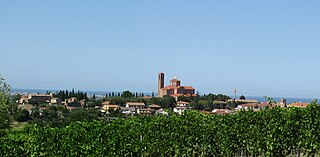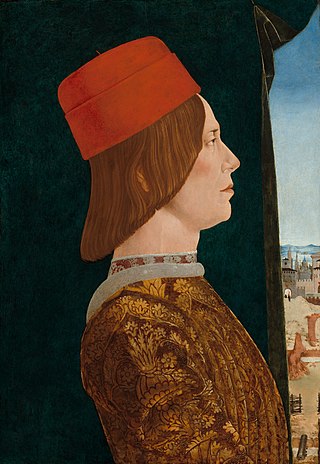Related Research Articles

Francesco I Sforza was an Italian condottiero who founded the Sforza dynasty in the duchy of Milan, ruling as its (fourth) duke from 1450 until his death.

Sigismondo Pandolfo Malatesta was an Italian condottiero and nobleman, a member of the House of Malatesta and lord of Rimini and Fano from 1432. He was widely considered by his contemporaries as one of the most daring military leaders in Italy and commanded the Venetian forces in the 1465 campaign against the Ottoman Empire. He was also a poet and patron of the arts.

Coriano is a comune in the province of Rimini. This town is known for being the town of the Motorcycle World Champion, in 250cc class, Marco Simoncelli.
Pandolfo III Malatesta was an Italian condottiero and lord of Fano, a member of the famous House of Malatesta. He was the father of the infamous Sigismondo Pandolfo Malatesta and Blessed Roberto Malatesta.

Roberto Malatesta was an Italian condottiero, or mercenary captain, lord of Rimini, and a member of the House of Malatesta.
Carlo I Malatesta was an Italian condottiero during the Wars in Lombardy and lord of Rimini, Fano, Cesena and Pesaro. He was a member of the powerful House of Malatesta. Carlo's wife was Elisabetta Gonzaga; they were married in November 1386. Francesco I Gonzaga married Carlo's sister Margherita Malatesta in 1393, cementing ties between the families. Carlo was the brother of Pandolfo III and Andrea Malatesta, with whom he fought in numerous occasions.
Malatesta II Malatesta, best known as Guastafamiglia was an Italian condottiero and lord of Rimini.
Luigi Alidosi was the lord of Imola from 1391 until 1424, the last ruler of the city from his family. He was the son of Bertrando Alidosi and Elisa Tarlati.

The Alidosi or Alodosi are a family of Romagna, Italy, who held the signoria of the city of Imola during the Late Middle Ages. They were originary of the Santerno valley.
Azzo Alidosi was an Italian condottiero and a lord of Imola.
Roberto Alidosi was a lord of Imola in the 14th century.
Ungaro Malatesta, born Galeotto Malatesta, was an Italian condottiero and lord of Jesi.
Galeotto I Malatesta (1299–1385) was an Italian condottiero from the House of Malatesta who was lord of Rimini, Fano, Ascoli Piceno, Cesena and Fossombrone.
RidolfoII da Varano, signore di Camerino, was a condottiero operating in Italy from the 1360s. His forebears had long held the rocca of Varano on the borderland of the Papal States, controlling a major strategic pass between Umbria and the Marche, a link between Rome and the Adriatic coast. He inherited from Gentile di Berardo da Varano in 1355, and undertook the improvement of the fortifications that protected the commune and its rocca.
Andrea Malatesta was an Italian condottiero, a member of the Malatesta family of Romagna. He is also known as Malatesta da Cesena, a city he had inherited in 1385 from his father, Galeotto, together with Cervia and Bertinoro. In 1388 he was also recognized lord of Fossombrone.
Antonia Malatesta of Cesena, also known as Antonia Malatesta of Rimini, was a Duchess of Milan by marriage to Giovanni Maria Visconti. She was the Regent of Milan in the interim after the death of her spouse in 1412.

Giovanni II Bentivoglio was an Italian nobleman who ruled as tyrant of Bologna from 1463 until 1506. He had no formal position, but held power as the city's "first citizen." The Bentivoglio family ruled over Bologna from 1443, and repeatedly attempted to consolidate their hold of the Signoria of the city.
Roderigo or Rodrigo Alidosi was an Italian nobleman, diplomat and courtier in the service of the Medici family. A member of Alidosi family, he was the penultimate lord of Castel del Rio.

Ciro Alidosi was a 16th-century Italian nobleman, diplomat, and lord of Castel del Rio, known for his service to the Medici and his controversial governance.
References
- ↑ Piffanelli, Luciano (2020). Politics and diplomacy in the Italy of the first resistance. Rome: Publications de l'École française de Rome. pp. 137–171.
- ↑ "Condottieri di ventura". 2008-04-25. Archived from the original on 2008-04-25. Retrieved 2023-05-28.
- ↑ "Galeotto Tarlati". geni_family_tree. 1335. Retrieved 2023-05-28.